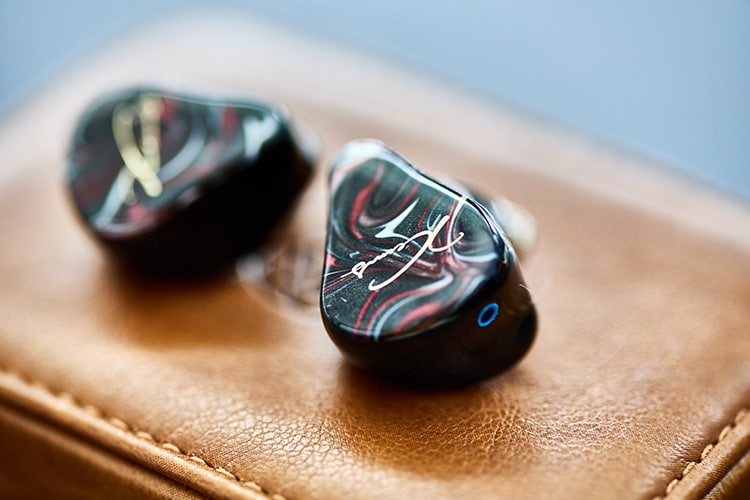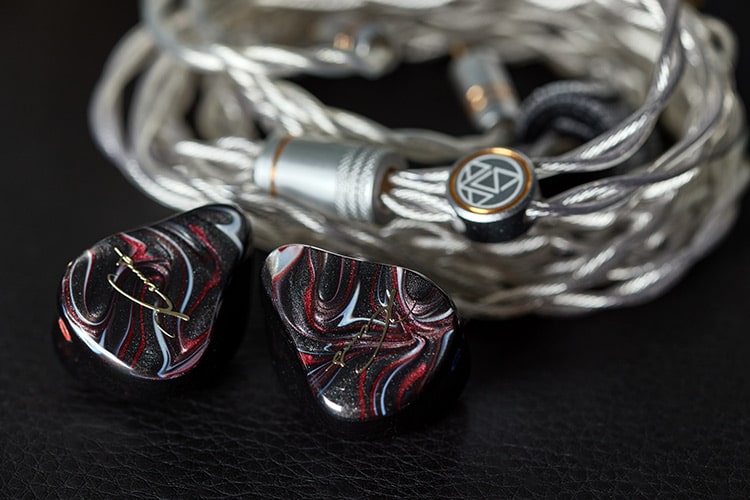In today’s article, we review the Mangird XENNS UP which is a flagship hybrid 7-driver in-ear monitor using electrostatic, dynamic, and BA drivers. It is priced at $699.99.
Disclaimer: This is a sample that was sent to us in exchange for our honest opinion. Headfonics is an independent website with no affiliate links or status. We thank Linsoul for giving us this opportunity.
To learn more about Mangird products that we have previously featured on Headfonics you can click here.
Note, that this article follows our latest scoring guidelines which you can read up on here.
The XENNS UP is Mangird’s flagship in-ear monitor at the time of writing and also one of their more complex in-ear monitors for driver implementation with a mix of electrostatic, dynamic, and BA.
However, at the end of the day, it’s not about the number of drivers but rather the quality of the overall sound. Does the Mangird XENNS UP live up to this expectation? Keep reading to find out.
Tech Highlights
The Mangird XENNS UP features 2 Electrostatic Drivers (EST), 4 balanced armatures, and 1 dynamic driver.
The ESTs are Sonion EST65DA01 ultra-high frequency drivers, whereas the balanced armatures are two custom Sonion high frequency and two Sonion 2300 mid-frequency drivers. The dynamic driver is a 10mm beryllium-coated driver.
The precise driving grouping is a dynamic driver for the sub and mid-bass, the four balanced armatures for the mids, and the electrostatic drivers for the highs.
Impedance is rated at 20Ω and 110dB SPL which means that the Mangird XENNS UP shouldn’t require too much power on paper but we all know through the last few years that EST drivers tend to be quite demanding.

Design
The Mangird XENNS UP IEM comes in a jet-black color resin shell featuring a hand-painted faceplate that dons a white and red sandstone texture.
Amidst all of this, the faceplate is topped off with a light layer of glitter with the word “Xenns” written on each faceplate in light gold lettering. Since the shells are made of resin and ergonomic, they are very lightweight and easy to handle.
Comfort & Isolation
The Mangird XENNS UP IEM is quite small and compact given it houses 7 drivers in total. The shape of the IEMs is very ergonomic which allows the Mangird XENNS UP to be very comfortable during use.
The nozzle is quite short but the insertion depth can be quite deep. This can be exemplified or mitigated depending on the ear tips in use. The isolation of the IEMs is excellent for me so there are no issues when it comes to unwanted noise escaping or seeping in.
The overall design of the Mangird XENNS UP is similar to other IEMS in the company’s lineup such as the Xenns Mangird Tea 2 which we reviewed earlier this year. Hence, if these or similar IEMs fit you well, then you will have no problems with the Mangird XENNS UP.
Tips
The Mangird XENNS UP comes with a large selection of ear tips in either foam or silicone. There are 2 sets of silicone tips and 1 set of foam ear tips.
The main difference between the 2 silicone sets is that one features a red and hard-core whereas the other houses a black and soft-core. The silicone ear tips come in the usual sizes including small, medium, and large whereas the foam tips come in small and medium only.
Overall, I preferred the black silicone ear tips the most because they produced the best overall sound and seal. The wide nozzle of the ear tips ensures that all sound frequencies leaving the drivers are undisturbed.

Stock Cable
The Mangird XENNS UP is supplied with a 6N OCC Silver plated Litz cable featuring 4 wires. The cable is very soft to the touch and has a shiny silver appearance.
The cable is supple and sits comfortably on top of each ear. During use, there were no issues regarding microphonics or cable noise. The cable braiding quality is excellent with evenly distributed overlaps and just the right amount of tension to keep the braids in place.
The splitter and cable plug have a silver metal finish and blend in well with the cable itself. The cable slider is small and circular and very lightweight. It does well to hold the cable in place and is topped with the “Mangird Xenns” logo.
You can also get the stock cable in different configurations such as a 0.78mm 2-pin or MMCX connectors with a 2.5mm termination. There is also a variety of adapters including 2.5mm to 3.5mm and 4.4mm plugs which makes the IEMs quite versatile.
The length of the cable is fixed at 1.2m or 3.9 feet or standard length with a supplied “XENNS” branded Velcro strap to assist with packing it away and storing it neatly.

Packaging & Accessories
The Mangird XENNS UP comes in a square, black box which is fitted with a sleeve depicting the same red and white sandstone finish as the IEM’s faceplates.
Within the box, you will find the IEMs, ear tips, a brown leather IEM case, cable clip, 3 adapters (2.5mm to 4.4mm and 3.5mm plus 2.5mm to airplane adaptor), a quality assurance certificate, and a VIP card.
The included IEM carrying case is a welcome inclusion with a robust finish for everyday usage. The case itself has a smooth leather finish on the outer and under the top of the lid, there is a small mesh compartment allowing you to store small accessories or interchangeable ear tips.
Sound Impressions
Overall, the Mangird XENNS UP has a very engaging sound profile which for me means it is mid-bass and mid-ranged orientated.
When it comes to the XENNS UP, it’s all about the energy of the music but you would be mistaken in thinking that this is a bass-heavy tuning. Rather it is a low-end which strikes a great balance between its mid-bass and mid-range performance. the mid-range is actually the most forward in terms of imaging but it is supported by a decent mid-bass boost.
Coupling this with an extensively tall and wide soundstage, the end result is quite impressive for an IEM at this price point.
Shortcomings? Probably in the treble region, although it depends where your own preferences lie. The XENNS UP highs come off as a bit dark and taper off the energy projected by the mid-bass and mid-range. I suspect the electrostatic drivers here have been gently applied.
The Cayin N8ii DAP was used as part of the testing process. It should be noted that other sources were used and compared during the review, and it was evident that the Mangird XENNS UP scales better with higher quality sources.
Input power is also important. The Mangird XENNS UP benefits from higher output power which is most likely due to the electrostatic driver setup. With more power, comes more headroom with an improved technical performance in the mid-range, and better mid-bass control.
Bass
The Mangird XENNS UP is a mid-bass focussed IEM where there is a noticeable presence. It is not emphasized to the point where it becomes a bass head IEM but instead, there is a slight bass boost to make it noticeable enough which allows it to strike a coherent balance with the mid-range.
Sub-bass depth is deep and rumble is present but only when called upon. Furthermore, the sub-bass is not as forward as the mid-bass. Instead, the mid-bass has its time to shine and produces a decent amount of boom and slam.
Mid-bass texture and quality are very high allowing drums and bass guitars to come off with just the right amount of impact.
Mids
The lower and upper mid-range of the Mangird XENNS UP is presented with a high level of detail and quality which comes off as effortlessly lush and smooth. Vocals and instrumentals sound natural and organic.
The Mangird XENNS UP is able to reveal large amounts of detail within the midrange, particularly female vocals and string instruments such as guitars. The mid-range is the most forward sound frequency and overtakes the bass and treble. Timbre-wise, the XENNS UP leans towards the warm side.
Treble
Treble on the Mangird XENNS UP is dark and presented behind the midrange and mid-bass. It does not have a high level of sparkle and instead focuses on subtle extension and detail.
The treble extension is definitely above average and detail retrieval is high. High hats are presented with great detail and have enough zing to make them noticeable throughout the sound signature.
If you prefer your treble to be sparkly, bright, and energetic, this may be a drawback for you as it does suck some of the energy out of the overall sound signature.
However, in my view, the dark treble compliments the overall sound of the Mangird XENNS UP well as it allows the mid-bass and mid-range to shine and take center stage.
Staging
The soundstage is very wide with enough space to make you feel like you’re in a concert hall. The width compliments the mid-range focused sound signature. Imaging and layering of instruments are excellent where there is accurate placement with sufficient space between each other.

Synergy
Efficiency
Coming in with 20Ωand 110db SPL sensitivity, it might seem easy enough to drive. However, the Mangird XENNS UP requires more than average power and gain to drive. This is probably due to its complex driver configuration, especially with electrostatic drivers, (possibly a gen 1 Sonion transformer).
With both the Cayin N8ii and Cayin N6ii Ti DAPs, the Cayin N8ii was the noticeably better pairing due to its P+ mode which allowed it to pump more voltage into the IEMs thus producing a better overall sound.
USB-C dongles such as the Cayin RU6 also worked well and there was no hissing or background noise whilst the IEMs were in use with any sources during testing.
Pairings
The Mangird XENNS UP paired well with all sources during testing however it performed best when connected to a neutral DAP or source.
The reason being is that without any further coloration, the mid-range was really able to come out to its full potential. As mentioned earlier, the Mangird XENNS UP requires power in order to perform at its best. As such, the Cayin N8ii was my most suitable source.

Select Comparisons
Empire Ears Bravado MK II
$799
Technical
The Empire Ears Bravado MK II has a similar tribrid design to the XENNS UP and features 4 proprietary drivers: 1 dynamic or “Weapon IX+” driver, 1 balanced armature, and 2 electrostatic drivers.
The Bravado MK II has a 6-way synX Crossover Network. It has an impedance rating of 4Ω and a sensitivity rating of 99dB. Interestingly, the Bravado MK II does require more power to drive compared to the Mangird XENNS UP though I am aware that it uses the 2nd Gen Sonion transformers which are more efficient.
Design
The Bravado MK II features a similar black resin shell as the XENNS UP but instead, it has a “deep field” themed faceplate. The Bravado MK II is slightly bigger than the XENNS UP and has a longer nozzle. Cable-wise, the Bravado MK II comes with an Alpha IV 26 AWG UPOCC Litz Copper cable similar to the EA Ares II.
Performance
The Bravado MK II is a bassier IEM with a comparatively recessed mid-range. The sub-bass, depth, and extension are much deeper on the Bravado MK II . The Bravado MK II has much more rumble and you can really tell it’s built to knock your socks off.
The mid-bass is much more forward on the Bravado MK II with more volume, slam, and impact. This contrasts slightly with the Mangird XENNS UP where even though the mid-bass is forward, it does not have the same amount of quantity, slam, or forwardness in the overall sound signature.
The mid-bass texture quality is very good on both IEMs however the Bravado MK II is slower to decay. As a result, it is quite evident that the Bravado MK II tends more towards the sub-bass and mid-bass frequencies.
The mid-range on the XENNS UP is more forward, expansive, and resolving. As the sub-bass and mid-bass take a back seat compared to the Bravado MK II, this allows the mid-range on the XENNS UP to really shine and become the main focal point of the sound signature.
The XENNS UP has a higher level of detail in the mids and comes off as smoother and more natural. Treble is one area where the two IEMs align and both have a dark presentation.
The soundstage is wider and taller on the Mangird XENNS UP and you really feel that there is more space and openness in the overall sound. This is probably due to the lower mid-bass presence.
Imaging and layering on the Mangird XENNS UP have noticeably better accuracy, placement, and space which is most likely due to its wider overall soundstage. Timbre-wise, the Bravado MK II has a warmer sound compared to the Mangird XENNS UP.

Xenns Mangird Tea2
$349
Technical
The Xenns Mangird Tea2 features a hybrid driver system housing 6 balanced armatures and 1 dynamic driver with an impedance of 18Ω and 110dB of sensitivity which is relatively close to the performance specs of the XENNS UP.
Design
The IEM shells of the Xenns Mangird Tea2 are individually handcrafted and are made from a German medical-grade resin. The result is a hard and acrylic-like shell that is highly durable and smooth to the touch.
Similar to the Mangird XENNS UP, the word “Mangird” is written towards the top of the faceplate in gold lettering which gives it a nice finish.
Performance
Overall, the Xenns Mangird Tea 2 has an equally forward mid-range with more mid-bass and brighter treble compared to the Mangird XENNS UP. However, the overall quality and resolution of the mid-range are noticeably better than the Tea2.
Sub-bass rumble and depth are similar between the two however when it comes to the mid-bass, differences start to appear. the mid-bass on the Xenns Mangird Tea2 has more volume, and slam and it is also more intimate in general.
The mid-bass on the Tea2 has a slower level of decay whereas the Mangird XENNS UP mid-bass presentation has less forwardness but an improved level of texture and better control.
Mid-range on both IEMs is the most forward aspect with the higher overall quality, resolution, and smoothness belonging to the XENNS UP. Female vocals and string instruments sound more natural and organic on the XENNS UP.
Treble on the Mangird Tea2 has more sparkle and comes off brighter compared to the XENNS UP which leans towards the darker side. Treble extends further with a higher level of detail on the XENNS UP compared to the Mangird Tea2.
The soundstage is wider and taller on the XENNS UP compared to the Mangird Tea2 which adds to more accurate imaging and layering in its presentation.

Our Verdict
With its well-textured and controlled mid-bass coupled with the high level of detail in the mid-range and wide soundstage, the Mangird XENNS UP is able to produce a very engaging sound capable of drawing anyone’s attention.
The dark treble presentation does reduce the energy from the sound signature however it allows the mid-range and mid-bass to shine. If you haven’t done so already, grab a powerful DAP and hook it up to the Mangird XENNS UP. It’s a surprisingly good offering for its price point.
Mangird XENNS UP Specifications
- Impedance ± 20 ohms
- Frequency response range 20-80Khz
- Sensitivity 110±1DB




